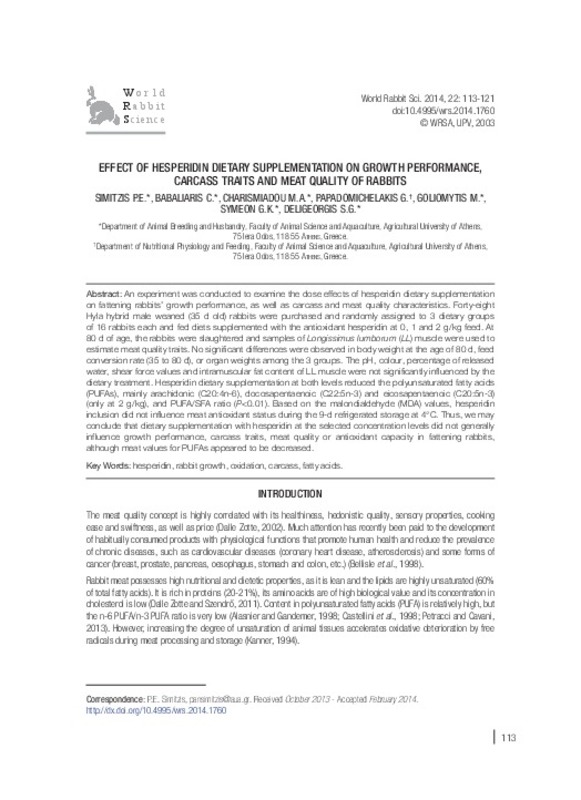JavaScript is disabled for your browser. Some features of this site may not work without it.
Buscar en RiuNet
Listar
Mi cuenta
Estadísticas
Ayuda RiuNet
Admin. UPV
Effect of hesperidin dietary supplementation on growth performance, carcass traits and meat quality of rabbits
Mostrar el registro sencillo del ítem
Ficheros en el ítem
| dc.contributor.author | Simitzis, P.E.
|
es_ES |
| dc.contributor.author | Babaliaris, C.
|
es_ES |
| dc.contributor.author | Charismiadou, M.A.
|
es_ES |
| dc.contributor.author | Papadomichelakis, G.
|
es_ES |
| dc.contributor.author | Goliomytis, M.
|
es_ES |
| dc.contributor.author | Symeon, G.K.
|
es_ES |
| dc.contributor.author | Deligeorgis, S.G.
|
es_ES |
| dc.date.accessioned | 2014-09-12T10:14:31Z | |
| dc.date.available | 2014-09-12T10:14:31Z | |
| dc.date.issued | 2014-06-25 | |
| dc.identifier.issn | 1257-5011 | |
| dc.identifier.uri | http://hdl.handle.net/10251/39593 | |
| dc.description.abstract | [EN] An experiment was conducted to examine the dose effects of hesperidin dietary supplementation on fattening rabbits’ growth performance, as well as carcass and meat quality characteristics. Forty-eight Hyla hybrid male weaned (35 d old) rabbits were purchased and randomly assigned to 3 dietary groups of 16 rabbits each and fed diets supplemented with the antioxidant hesperidin at 0, 1 and 2 g/kg feed. At 80 d of age, the rabbits were slaughtered and samples of Longissimus lumborum (LL) muscle were used to estimate meat quality traits. No significant differences were observed in body weight at the age of 80 d, feed conversion rate (35 to 80 d), or organ weights among the 3 groups. The pH, colour, percentage of released water, shear force values and intramuscular fat content of LL muscle were not significantly influenced by the dietary treatment. Hesperidin dietary supplementation at both levels reduced the polyunsaturated fatty acids (PUFAs), mainly arachidonic (C20:4n-6), docosapentaenoic (C22:5n-3) and eicosapentaenoic (C20:5n-3) (only at 2 g/kg), and PUFA/SFA ratio (P<0.01). Based on the malondialdehyde (MDA) values, hesperidin inclusion did not influence meat antioxidant status during the 9-d refrigerated storage at 4°C. Thus, we may conclude that dietary supplementation with hesperidin at the selected concentration levels did not generally influence growth performance, carcass traits, meat quality or antioxidant capacity in fattening rabbits, although meat values for PUFAs appeared to be decreased. | es_ES |
| dc.language | Inglés | es_ES |
| dc.publisher | Editorial Universitat Politècnica de València | |
| dc.relation.ispartof | World Rabbit Science | |
| dc.rights | Reserva de todos los derechos | es_ES |
| dc.subject | Hesperidin | es_ES |
| dc.subject | Rabbit growth | es_ES |
| dc.subject | Oxidation | es_ES |
| dc.subject | Carcass | es_ES |
| dc.subject | Fatty acids | es_ES |
| dc.title | Effect of hesperidin dietary supplementation on growth performance, carcass traits and meat quality of rabbits | es_ES |
| dc.type | Artículo | es_ES |
| dc.date.updated | 2014-09-12T09:37:35Z | |
| dc.identifier.doi | 10.4995/wrs.2014.1760 | |
| dc.rights.accessRights | Abierto | es_ES |
| dc.description.bibliographicCitation | Simitzis, P.; Babaliaris, C.; Charismiadou, M.; Papadomichelakis, G.; Goliomytis, M.; Symeon, G.; Deligeorgis, S. (2014). Effect of hesperidin dietary supplementation on growth performance, carcass traits and meat quality of rabbits. World Rabbit Science. 22(2):113-121. https://doi.org/10.4995/wrs.2014.1760 | es_ES |
| dc.description.accrualMethod | SWORD | es_ES |
| dc.relation.publisherversion | https://doi.org/10.4995/wrs.2014.1760 | es_ES |
| dc.description.upvformatpinicio | 113 | es_ES |
| dc.description.upvformatpfin | 121 | es_ES |
| dc.type.version | info:eu-repo/semantics/publishedVersion | es_ES |
| dc.description.volume | 22 | |
| dc.description.issue | 2 | |
| dc.identifier.eissn | 1989-8886 | |
| dc.description.references | Alasnier, C., & Gandemer, G. (1998). Fatty acid and aldehyde composition of individual phospholipid classes of rabbit skeletal muscles is related to the metabolic type of the fibre. Meat Science, 48(3-4), 225-235. doi:10.1016/s0309-1740(97)00096-x | es_ES |
| dc.description.references | Castellini, C., Dal Bosco, A., Bernardini, M., & Cyril, H. . (1998). Effect of Dietary Vitamin E on the Oxidative Stability of Raw and Cooked Rabbit Meat. Meat Science, 50(2), 153-161. doi:10.1016/s0309-1740(98)00026-6 | es_ES |
| dc.description.references | Dalle Zotte, A., & Szendrő, Z. (2011). The role of rabbit meat as functional food. Meat Science, 88(3), 319-331. doi:10.1016/j.meatsci.2011.02.017 | es_ES |
| dc.description.references | De Blas, C., Mateos, G.G., 1998. Feed formulation. In: de Blas, C., Wiseman, J. (Eds.), The Nutrition of the Rabbit. Wallingford, UK. CAB International, 241-253. | es_ES |
| dc.description.references | Fundacion Espa-ola para el Desarrollo de la Nutricion Animal (FEDNA), 2003. In: de Blas, C., Mateos, G.G., Rebollar, P.G. (Eds.), Tablas FEDNA de composicion y valor nutritivo de alimentos para la fabricacion de piensos compuestos. 2nd ed. FEDNA, Madrid, Spain. | es_ES |
| dc.description.references | Folch J., Lees M., Stanley S.G.H. 1957. A simple method for the isolation and purification of total lipids from animal tissues. J. Biol. Chem., 226: 497-509. | es_ES |
| dc.description.references | Sas Institute INC. 2005. Statistical analysis systems user's guide. Version 9.1.3. SAS Institute, Inc., Cary, NC. | es_ES |
| dc.description.references | Wenk C. 2003. Herbs and botanicals as feed additives in monogastric animals. Asian-Austr. J. Anim. Sci., 16: 282-289. | es_ES |








